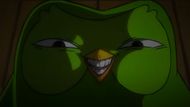The Duolingo anime is officially real; that green owl has somehow become a magical mascot hero. Titled 最後の決戦 (The Final Test), the short-form series premieres on October 13 on Duolingo’s YouTube channel. But instead of uniting fans, the trailer has divided the internet in a way few marketing campaigns ever could.
So, is the Duolingo anime a hilarious mistake or something worth watching? Honestly both. It’s unapologetically bizarre, possibly inauthentic, but undeniably fascinating. It may not rival Attack on Titan, but it doesn’t have to. The point is to entertain, intrigue, and maybe even teach you a little Japanese along the way.
At worst, it’s corporate absurdity at its peak. At best, it’s a reminder that even a green owl can dream big. One thing’s for sure: when The Final Test drops on October 13, the internet will be watching, if only to see just how far Duo will go to keep your streak alive.

When the Duolingo anime trailer dropped, social media exploded with disbelief. The biggest complaint? It wasn’t made in Japan. Purists argue that anime is defined not only by its art style but by its Japanese origin and storytelling culture. Critics accuse Duolingo of cultural mislabeling, suggesting that slapping Japanese dialogue and magical-girl tropes onto Western animation doesn’t make it authentic.
But origin debates aside, others have aimed at the animation itself. Several viewers drew uncomfortable comparisons to Steven Universe, from rounded character designs to the fluid but overly simplified motion. Some critics described it as “trying too hard to imitate Japanese shorts, yet lacking the nuance of real anime direction.”
Inside “The Final Test”

The five-episode mini-series, with Duolingo anime episodes running about 60 seconds, introduces a new lore for Duo the Owl and his friends. Before they became “guardians of the streak,” they were ordinary people recruited by Duo to protect learners’ motivation.
The tone is playful, self-aware, and intentionally dramatic, like a Sailor Moon parody wrapped in corporate branding. Interestingly, Duo doesn’t speak in human words. Instead, his dialogue is composed of chirpy in-app sounds like “wah-bing,” adding to the absurd charm.
The show will be entirely in Japanese, with subtitles available in English, Spanish, Hindi, French, German, Korean, Portuguese, and Thai, making it accessible to a massive global audience.
The anime ties directly into Duolingo’s latest campaign: updated Japanese courses are now available to users learning from any language. It’s both a marketing stunt and a cultural crossover, blending anime aesthetics with brand storytelling in a way no other educational app has dared to attempt.
Is the Duolingo anime marketing masterstroke or meme material?

At first glance, this project sounds ridiculous: a language-learning mascot in a magical anime transformation sequence. But it’s also weirdly brilliant. By embracing the absurdity, Duolingo has created a campaign that perfectly fits the internet’s love for irony and meme culture.
There’s also a strategic side. Anime is a massive global phenomenon, especially among younger audiences, the same demographic most likely to use Duolingo. As CMO Manu Orssaud explained, “For many, anime is the spark that gets them excited to learn Japanese. With The Final Test, we’re expanding our universe in a streak-obsessed, unmistakably Duolingo way.”
It helps that Duolingo has turned the release into a full-scale event. The trailer premiered at New York Comic Con, alongside exclusive plushies, enamel pins, and in-app themed animations. The anime isn’t just a show; it’s an interactive experience tied to the platform’s branding ecosystem.
